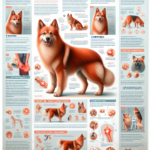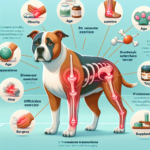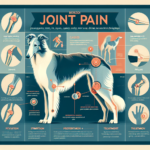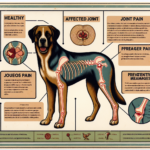Finnish Spitz Joint Pain: Causes, Symptoms, Prevention, and Treatment

Introduction
The Finnish Spitz, often referred to as the “Barking Bird Dog,” is a breed known for its vibrant personality, fox-like appearance, and exceptional hunting skills. Originating from Finland, this breed has a rich history dating back over a thousand years. Finnish Spitz dogs were initially bred to hunt game birds and small mammals, using their keen senses and distinctive barking to alert hunters. They are medium-sized dogs with a dense, golden-red coat, erect ears, and a curled tail, making them both striking and functional in their appearance.
While the Finnish Spitz is generally a healthy breed, they are not immune to certain health issues. Common concerns include dental problems, eye conditions, and notably, joint pain. Joint health is particularly crucial for this breed due to their active nature and hunting background. Ensuring that a Finnish Spitz maintains healthy joints is essential for their overall well-being and quality of life.
Breed-Specific Joint Pain Risks
Genetic Predisposition
Like many breeds, the Finnish Spitz is genetically predisposed to certain joint-related issues. Hip dysplasia, a condition where the hip joint does not fit properly into the hip socket, is a common concern. This can lead to arthritis and significant pain over time. Elbow dysplasia, another genetic condition, affects the elbow joints and can cause similar issues. Both conditions are hereditary, meaning that responsible breeding practices are crucial in minimizing their prevalence.
Age-Related Risks
As Finnish Spitz dogs age, the risk of developing joint pain increases. Arthritis, a degenerative joint disease, is particularly common in older dogs. For the Finnish Spitz, signs of joint pain may start to appear around the age of 7 or 8, although this can vary. It’s essential for owners to be vigilant as their dogs age, watching for any signs of discomfort or mobility issues.
Activity Level and Joint Stress
The Finnish Spitz is an active and energetic breed, often used for hunting and other high-energy activities. While their activity level is beneficial for their overall health, it can also contribute to joint stress. Repetitive motions, jumping, and running can all place strain on the joints, potentially leading to wear and tear over time. It’s important to balance their need for exercise with measures to protect their joints.
Common Symptoms of Joint Pain in Finnish Spitz
General Symptoms
Owners should be aware of several common symptoms of joint pain in their Finnish Spitz:
- Limping: A noticeable limp or favoring one leg over another can indicate joint pain.
- Stiffness: Difficulty moving, especially after resting, is a common sign of joint issues.
- Reluctance to Move: A dog that is hesitant to jump, run, or climb stairs may be experiencing joint pain.
- Swelling: Visible swelling around the joints can be a sign of inflammation.
- Behavioral Changes: Increased irritability or changes in behavior can also indicate discomfort.
Breed-Specific Symptoms
In Finnish Spitz dogs, joint pain may manifest in specific ways due to their unique characteristics. For instance, their high energy levels may make a sudden decrease in activity more noticeable. Additionally, their vocal nature means they might whine or bark more when in pain. Owners should pay close attention to these breed-specific signs.
When to Consult a Vet
If any of the above symptoms are observed, it’s crucial to consult a veterinarian promptly. Early intervention can prevent further deterioration and improve the dog’s quality of life. Regular veterinary check-ups are also essential for monitoring joint health, especially as the dog ages.
Preventive Measures for Joint Health
Exercise Recommendations
Maintaining an appropriate exercise routine is vital for the Finnish Spitz. While they need regular physical activity to stay healthy, it’s important to avoid high-impact exercises that can strain their joints. Activities like swimming, which provide a good workout without putting stress on the joints, are ideal. Regular, moderate walks and controlled play sessions are also beneficial.
Dietary Suggestions
A balanced diet rich in nutrients that support joint health is essential. Foods containing glucosamine and chondroitin can help maintain cartilage health. Omega-3 fatty acids, found in fish oil, have anti-inflammatory properties that can benefit joint health. Owners should consult their veterinarian for specific dietary recommendations and consider supplements if necessary.
Weight Management
Maintaining a healthy weight is crucial for reducing joint stress. Excess weight can exacerbate joint issues and lead to more severe pain. Owners should monitor their Finnish Spitz’s weight and adjust their diet and exercise routine as needed to prevent obesity.
Early Screening and Monitoring
Regular veterinary check-ups and early screening for joint issues can help catch problems before they become severe. For breeds like the Finnish Spitz, veterinarians may recommend specific tests or imaging to monitor joint health. Early detection allows for more effective management and treatment.
Treatment Options for Joint Pain
Non-Surgical Treatments
Several non-surgical treatment options can help manage joint pain in Finnish Spitz dogs:
- Medications: Anti-inflammatory drugs and pain relievers can help manage symptoms.
- Physical Therapy: Exercises and therapies designed to strengthen muscles and improve joint function can be beneficial.
- Lifestyle Adjustments: Modifying the dog’s activity level and environment to reduce joint stress can help alleviate pain.
Surgical Options
In severe cases, surgical intervention may be necessary. Common surgeries for joint issues include:
- Hip Replacement: Replacing the damaged hip joint with an artificial one can significantly improve mobility and reduce pain.
- Arthroscopy: A minimally invasive procedure to clean out the joint and remove damaged tissue.
- Joint Fusion: Fusing the joint to prevent movement and reduce pain in cases of severe arthritis.
Alternative Therapies
Alternative treatments can also provide relief for joint pain:
- Acupuncture: This traditional Chinese medicine technique can help reduce pain and inflammation.
- Hydrotherapy: Water-based exercises that provide a low-impact workout for the joints.
- Massage: Regular massage can help improve circulation and reduce muscle tension around the joints.
Lifestyle and Management Tips
Daily Care Routine
A consistent daily care routine can help manage joint pain in Finnish Spitz dogs. This might include:
- Regular, gentle exercise to maintain mobility without overstraining the joints.
- A balanced diet with supplements as recommended by a veterinarian.
- Administering any prescribed medications or treatments.
- Monitoring the dog’s weight and adjusting their diet and exercise as needed.
Modifying the Home Environment
Making the home more comfortable for a dog with joint pain can significantly improve their quality of life. Consider the following modifications:
- Installing ramps to help the dog navigate stairs or get onto furniture.
- Providing orthopedic beds that offer better support for their joints.
- Ensuring that food and water bowls are at a comfortable height to reduce strain.
Long-Term Management
Long-term management of joint pain involves ongoing care and monitoring. Regular veterinary check-ups, maintaining a healthy lifestyle, and being vigilant about any changes in the dog’s condition are all crucial. With proper management, a Finnish Spitz can continue to lead an active and happy life despite joint pain.
FAQs About Finnish Spitz and Joint Pain
What are the early signs of joint pain in Finnish Spitz dogs?
Early signs include limping, stiffness, reluctance to move, and behavioral changes such as increased irritability. If you notice any of these symptoms, consult your veterinarian promptly.
Can joint pain in Finnish Spitz be prevented?
While genetic predispositions cannot be entirely prevented, maintaining a healthy weight, providing a balanced diet, and ensuring regular, low-impact exercise can help reduce the risk of joint pain.
Are there specific foods that can help with joint health?
Yes, foods rich in glucosamine, chondroitin, and omega-3 fatty acids can support joint health. Consult your veterinarian for specific dietary recommendations and consider supplements if necessary.
When should I consider surgery for my dog’s joint pain?
Surgery is typically considered when non-surgical treatments are no longer effective, and the dog’s quality of life is significantly impacted. Your veterinarian can help determine the best course of action based on your dog’s condition.
What alternative therapies are effective for joint pain in Finnish Spitz?
Alternative therapies such as acupuncture, hydrotherapy, and massage can provide relief for joint pain. These treatments can be used in conjunction with traditional methods for a comprehensive approach to managing joint pain.
Conclusion
Joint pain is a significant concern for Finnish Spitz dogs, but with proper care and management, it can be effectively addressed. By understanding the breed-specific risks, recognizing early symptoms, and taking preventive measures, owners can help ensure their Finnish Spitz remains healthy and active. Regular veterinary check-ups, a balanced diet, appropriate exercise, and weight management are all crucial components of maintaining joint health. If joint pain does develop, a range of treatment options, including medications, physical therapy, and even surgery, can provide relief. With the right approach, Finnish Spitz dogs can continue to lead happy, fulfilling lives despite joint pain.




